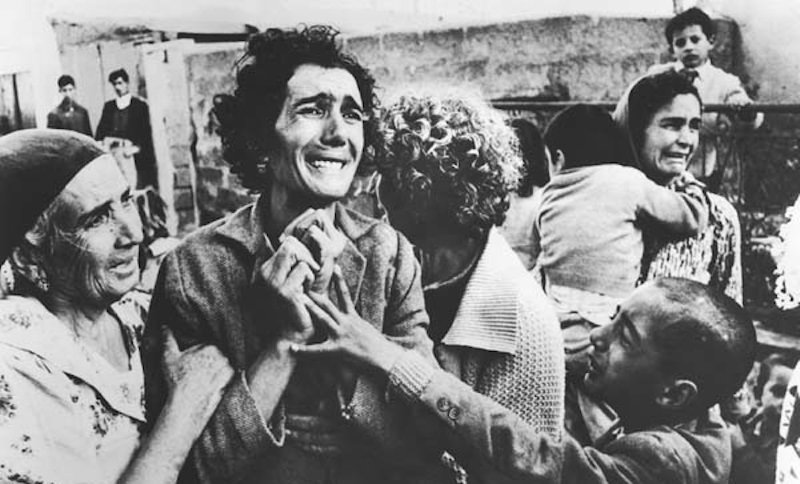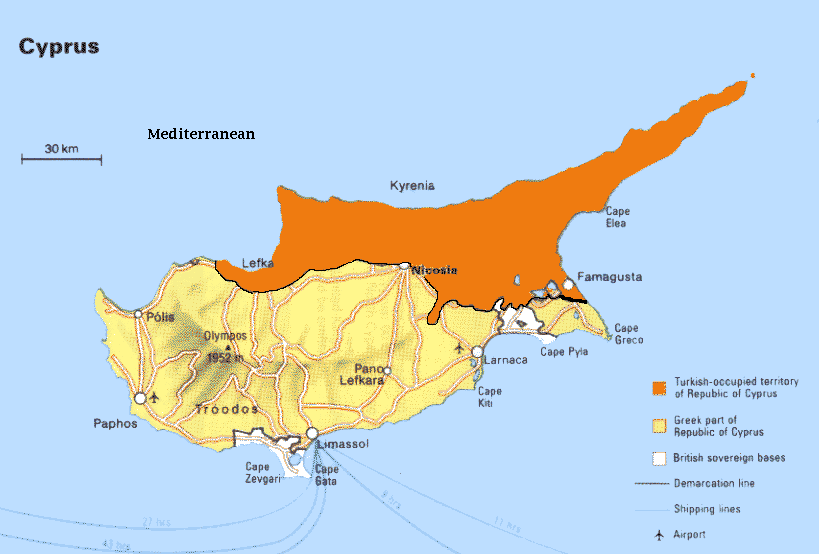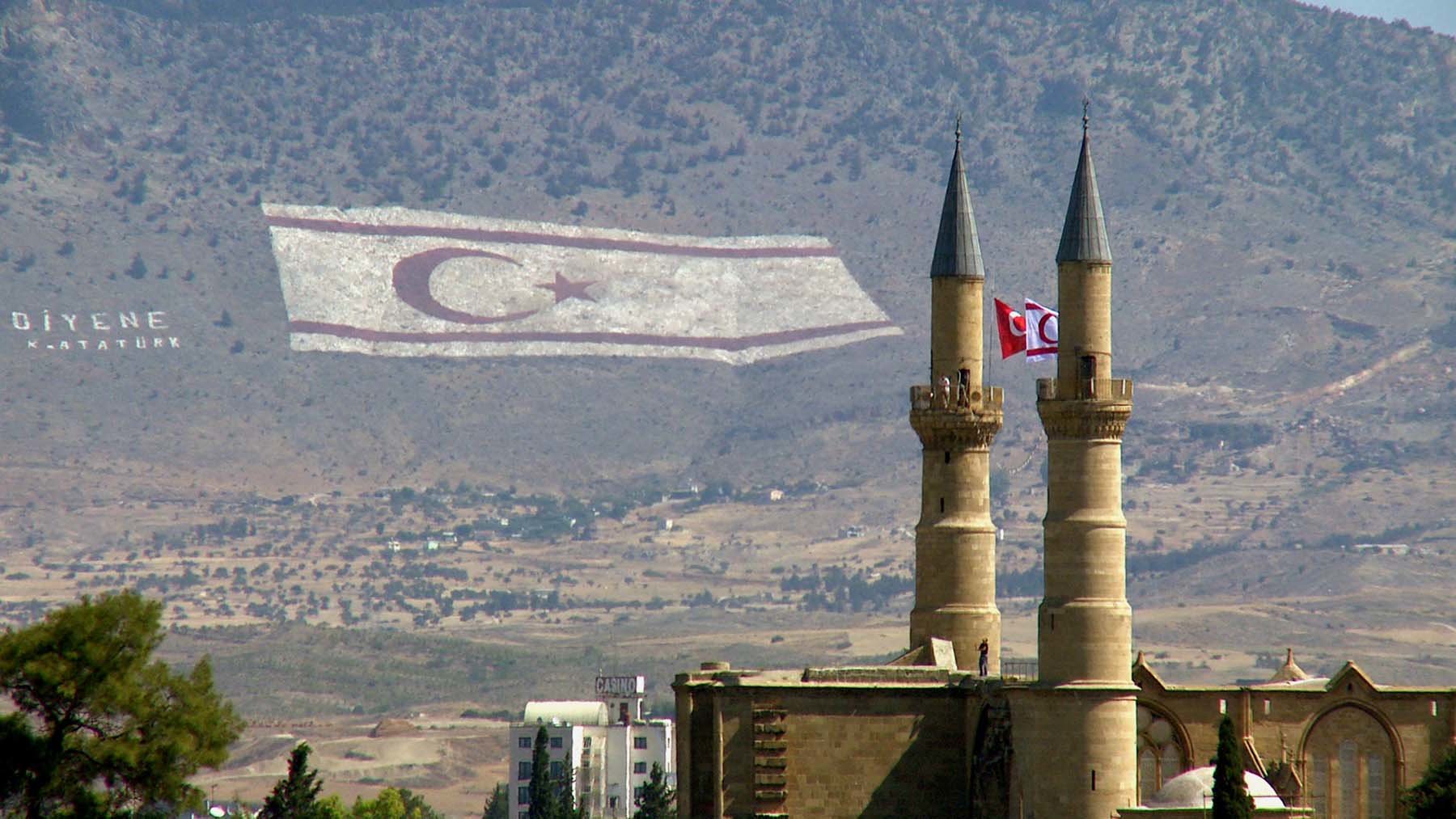Mens Tyrkiet fortsætter med at shokere og forstyrre verden med sin radikale og uforudsigelige adfærd, fra at støtte IS i Syrien, til kuppet fornyligt og den efterfølgende udrensning under Erdogan som nu finder sted, gentager historien ikke nødvendigvis sig selv, men den rimer ihvertfald.
Og mens dagen idag ganske sikkert vil gå ubemærket hen for det meste af verden, så markerer dagen for Kypern og Grækenland det 42. år af Tyrkiets invasion og besættelse af det nordlige Kypern, i hvad der var en brutal gengældelse imod de græske kyprioter for et kup som var befalet af en regerende militær junta på det græske fastland i 1974.
Kup, invasioner og besættelse. Ja, historien rimer minsanten [på engelsk rimer invasion med occupation] Mens det græske demokrati blev genetableret efter det forfejlede kypriotiske kup, så betalte Kypern den ultimative pris ved at miste 37% af det nordlige territorium til det næststørste militær i NATO.
I 1974, iværksatte omkring 40,000 tyrkiske tropper, under kommandoen af løjtnant Nurettin Ersin deres invasionsplan med kode-navnet 'Attila', invaderede ulovligt Kypern i strid med FN Sikkerhedsråds charter.
Sigma Live gengiver en kort historie af begivenhederne som udfoldede sig i sommeren 1974...
Kommentar: Denne artikel er delvis oversat til dansk af sott.net fra: 42 years ago today Turkey invaded Cyprus - occupation continues to this day
Turkey launched the invasion following the coup d'état on July 15, 1974 that had been ordered by the military Junta in Greece and staged by the Cypriot National Guard in conjunction with EOKA-B.After the first wave of the invasion in July, the Greek military junta collapsed and was replaced by a democratic government. In August 1974, another Turkish invasion resulted in the capture of approximately one-third of the island.
It deposed then-Cyprus President Archbishop Makarios III and installed pro-Enosis Nikos Sampson. The aim of the coup was the annexation of the island by Greece, and the so-called Hellenic Republic of Cyprus was declared.
In a country already wounded by the coup, which opened the doors to Attila, the resistance was minimal. The invasion on July 20 was the first part of the Cyprus tragedy. On August 14, 1974 the tragedy ended with the occupation of Famagusta and the Karpas Peninsula.
Turkish forces landed on Cyprus' northern coast, near Kyrenia, and advanced south towards the capital Nicosia. The large, US equipped, Turkish military quickly over took more than a third of the island. The small Cyprus army was no match for Attila's troops.
Invading Turkish forces killed 4,000 men, women and children from Kyrenia and the villages surrounding Nicosia.More than a quarter of the population was expelled from the north of Cyprus, where Greek Cypriots once constituted 80 per cent of the population.Around 200,000 Greek Cypriots were driven from their homes and became refugees in their own country.
1,619 people are still missing, while Turkey still illegally occupies 37% of Cyprus' territory.
The ceasefire line from August 1974 became the United Nations Buffer Zone in Cyprus, and is commonly referred to as the Green Line.
In the government-held south, the event is commemorated as a "black anniversary". In the illegally occupied north, the events from 1974 are celebrated with an annual parade, which this year will not include tanks and aircraft, because of the ongoing events in Turkey.
Despite the 'black anniversary' Cypriot President Nicos Anastasiades said he would be meeting Turkish Cypriot leader Mustafa Akinci as planned on Friday. "I do not see any reason to cancel the talks that would normally take place," Anastasiades said.
SigmaLive adds context on where Cyprus problem stands today...
Leader after leader since that terrible day has been engaged in countless meetings in an attempt to find a solution to the illegal division of the island.Via Sigma Live
The baton is currently in the hands of Cyprus President Nicos Anastasiades and Turkish Cypriot leader Mustafa Akinci, who are working for a solution under UN auspices with the UN Secretary General's Special Representative on Cyprus, Espen Barth Eide, and the United Nations Peacekeeping Force (UNFICYP) led by Elizabeth Spehar.
Anastasiades and Akinci have expressed their hope that a solution can be reached in 2016, with both also stating that they are jointly the best hope the island has had since the invasion for reunification.
Over the years Cypriots have learnt to be cautious regarding political promises, and view with a sense of calculated optimism any promises made regarding the reunification of the island. However, Anastasiades and Akinci have given hope to the citizens of an island still divided.
And all Cypriots - Greek and Turkish - are surely hoping that in 12 months, on July 20, 2017, it will not be the sirens that wake them from their slumber, but the sun rising on a reunified Cyprus, devoid of occupying forces and divisions and with equal rights for all.








Læserkommentarer
dig vores Nyhedsbrev